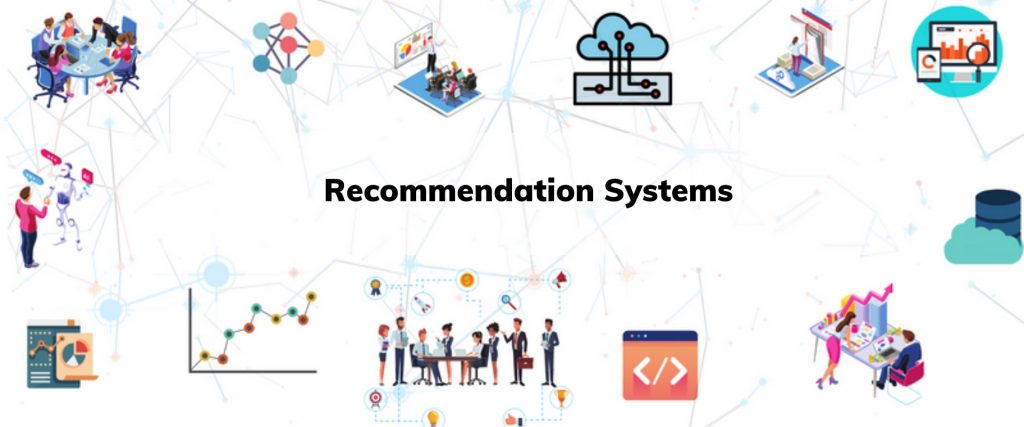In this blog, we would be going through the topic of recommendation systems. Now, what exactly are recommendation systems?
Recommendation systems refer to the systems that are designed with certain algorithms to provide the most relevant and accurate items to the user by filtering useful stuff from a huge information database. It’s thus like a predictive recommendation of what a certain user would like to see or buy depending on the platform.
thus. It aims to find a match between the user and the target item and then tries to make an accurate prediction based recommendation to the end- user.
Need for Recommendation Systems:-
There are several benefits of having a recommendation system like:-
- Increases user engagements
- Providing a personalized experience to each user
- Helping users to find certain items that might be relevant for their needs
- Identifying the most relevant and popular items/products
What to Recommend ?
Now, what is to be recommended depends upon the specific platform. We have plenty of examples of recommendations from our day to day life like-
Amazon uses data from its customer’s database to identify which items are usually bought together and then makes recommendations based on that,
YouTube recommends videos, Netflix uses a recommender system to recommend movies & web-series to its users, Linkedin utilizes data from your past experience, current job titles to suggest suitable jobs to the user, etc.
Apart from this, Spotify, IMDB, Trip Advisor, Google News, and many other platforms continuously suggest recommendations to suit our needs.
In a recommendation system, there is nothing such as a perfect recommendation. Everything is like an accurate predictive suggestion that somehow would be relevant to the requirements of the user.
Let us understand this with the help of a real-life scenario:-
A user wants to buy a laptop with certain configurations according to his requirements. Now, a recommendation system would suggest the most similar laptops to the user. In our case 3 most similar laptops were recommended to the user.
Types of Recommendation Systems:-
(A) Popularity-Based Recommendation System:-
This type of recommendation system works on the principle of popularity and or anything in trend. This type of system checks for the product or movie currently trending or is most popular among the users and then recommends them to the users.
In this system, no previous records of the users are required for making recommendations as anything that is ongoing as a trend is recommended to all.
Not having a personalized experience is a disadvantage of this system.
Ex-Google news (filters the trending and popular news), Youtube (recommends trending videos).
(B). Content-Based Recommendation System:-
This type of recommendation system works on the principle of similar content. Consider a user watching a movie, then the system would check other movies of similar content or the same genre of the movie the user is watching. To give recommendations we compute distance calculation for any of the features of the product. The basic principle remains the same if the distance between both is 0, they are likely to have similar content and those are then further recommended.
For computing the similarity between numeric data, Euclidean distance is use whereas for textual data, cosine similarity is use for comparing the similarity between features of multiple products for deciding similarities.
Ex-One plus 8 and One plus 8T can be consider similar as they contain certain common specs.
(c) Classification Model:-
This model uses the features of both products as well as users to make a certain prediction of whether the user would like the product or not.
The output would be of the form 0 or 1.
It is an enormous task to collect such a high volume of information about different users and products and then classify.
(d) Collaborative Filtering:-
This system works upon the similarity between different users and also
Items. These are widely use on e-commerce websites and also online movie websites. however, This model uses the combination of ratings provided by the users/customers to make recommendations.
This system is divide up into:
- User-based nearest-neighbor collaborative filtering
Recommending items liked by other people having similar preferences.
- Item-based nearest-neighbor collaborative filtering
Recommending items that other people bought who also bought items that we liked.
Typical Recommender Pipeline:-
A typical recommender system pipeline consists of the following 5 phases.
For now, you could consider this as the basic pipeline structure for building any recommendation system. so, We would be seeing the detailed implementation of the pipeline structure in a separate blog.
Conclusion:-
so, The main purpose of writing this blog was to introduce you all to the basic idea behind what are ‘Recommendation Systems’ and their types. however, I would conclude the blog by stating that the recommendation systems made it easy for the users to choose their desired choices of interests and provided personalized content to the users.
Thank u and happy reading…!
written By: Rohit Kumar Mandal
reviewed by: Rushikesh Lavate
If you are Interested In Machine Learning You Can Check Machine Learning Internship Program
Also Check Other Technical And Non Technical Internship Programs

